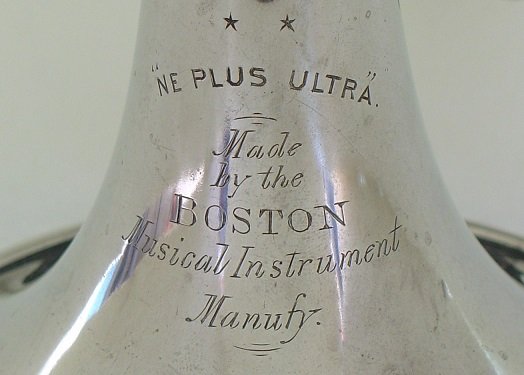Boston Two Star Cornet with a Twist
The Two Star cornet sometimes seems to be a poor relative to the Famous Three Star Cornets made by Boston Musical Instrument Manufactory, although sold for the same price with the same finish. The existing catalogs don't give many clues as to the difference in design and utility of the two models. They look virtually the same and the early versions had the same bore size of .487". The Two Star cornet does have a slightly larger bell flare, leading me to believe that it was intended more for the harmony or middle voice parts. The later Three Star cornets have a smaller bore (.472") through the valves as well, making more of a distinction.
Two Star cornets with rotary valves are vary rare with only four or five examples known. All others that I know of have piston valves. Notice, also, that this cornet is a continuation of the basic layout utilized by E.G. Wright about ten years earlier for his smaller bore band model cornet and could be seen as a precursor to the Boston Esbach's Patented Three Star cornet. We are fortunate that these cornets are so well preserved, only needing some dents removed, a few parts reproduced and, of course, they are excellent playing cornets.
The top action cornet in the first three photos is solid nickel silver and the side action example below, is silver plated brass. The length is 12 1/2", the bell rim diameter is 4 15/16" and the bore measures .487".
Below is the story of another Two Star Cornet that I assembled for myself:
This is a rare model with only four known examples (two with top action and two with side action) including this one. This one is a bit of a fake or recreation, made up from several parts horns and I originally didn't have any intention of featuring it on my website. What changed my mind was some thoughts that I had while spending a day at a fairly upscale car show in San Marino, California. My own car that I had there, a 1912 EMF Semi-Racer is a nice looking car, but has a newly made body that is not authentic. I have a lot of fun with it, but don't make any grand claims as to its historical importance or monetary value. Another car entered was a 1912 Mercer Raceabout, a car worth about 100 times as much as mine (you may think that this is an exaggeration, but it's not) and for the most part with all the correct and authentic parts. However, without trying very hard, I could find serial numbers on parts from three different cars. In other words this car was made up from parts from several original cars.
I know from experience that this is not an unusual case; there are many antique and classic cars that are restored in this way and it doesn't detract much from the desirability if the model is popular to begin with. Every restoration, whether cars or horns, almost always needs newly made parts to complete. Usually, the newly made parts are minor and don't detract much from thinking of the item as being authentic. For some of the most desired cars, they are sometimes made up from just a few original parts and the rest made new. In a few extreme cases, such as at least one Bugatti, there are two cars with the same serial number. Cars were built up from parts from one car that were found by two different enthusiastic owners without knowledge of each other.
As I said, this cornet has major parts taken from two original parts horns and some minor parts from others and newly made as well. I purchased an alto horn about twenty years earlier, recognizing that the valve section was from a rare top action Boston solo alto, the bell was from a Martin trombone and the mouthpipe and tuning slide assemblies were from a Buescher cornet. I had the idea that I would keep an eye out for an original Boston alto horn bell and recreate the rest. I later realized that the bells on Boston upright alto horns are different than those on the solo altos and it was not likely that I would find the parts that I wanted.
Years later, when I had Steve Ward's top action rotary valve Two Star cornet in my shop, I realized that the valve section was identical to the alto horn's, other than differing tubing length. The next thought was natural for me: I need to keep an eye out for an early piston valve Two Star cornet with wrecked valves but a restorable bell. This also seemed like a long shot, but I got lucky this time and just such a cornet came along soon after. It was an early, pre-serial number cornet made about 1880 that had been badly refinished many decades ago and then abused to an astonishing degree including ruining one piston and damaging the others. While technically restorable, the amount of effort and expense wasn't warranted and I had a better use for the bell, mouthpipe and miscellaneous crooks, tubing etc. I did need to make a number of new parts to complete the project as well. These included both the high and low pitch tuning slide assemblies, the crook that leads from the tuning slide to the third valve and eight braces, all copied from Steve Ward's original cornet.
After many hours of removing dents from the bell, I had to re-bend the curve to fit the valve section. This sort of thing was a daunting task when I was younger, but I've gotten fairly proficient at bending tubing over the years. I'm quite happy with the resulting cornet, not trying to pass it as an all original instrument, but a nice representation of a great old Boston cornet. It's quite a good player as well.







